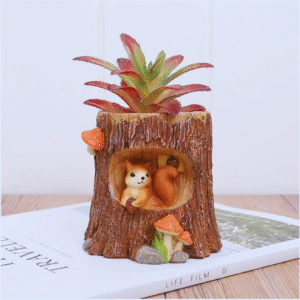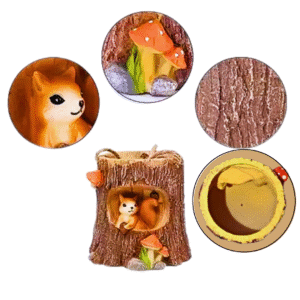Trees are among the most vital and symbolic natural elements on Earth. From providing oxygen to sheltering biodiversity, their significance is undeniable. But when we observe a tree, one of its most prominent and defining parts is the trunk. If you’ve ever wondered what trunk is, you’re about to discover not only its scientific meaning but also its cultural, symbolic, and even decorative relevance.
In this article, we’ll explore:
-
What a tree trunk is
-
Its function in nature
-
Its symbolic meaning across cultures
-
And how it inspires modern home décor like the Rustic Tree Trunk Flower Pot available at Murti Mall
What Is the Trunk of a Tree?
The trunk of a tree is the central, woody stem that supports the branches and leaves. It connects the roots to the canopy, serving as the main highway for transporting water, minerals, and nutrients throughout the plant.
In simpler terms, the trunk is
-
The main body of the tree
-
Located between the roots and the branches
-
Composed of multiple layers: bark, cambium, sapwood, and heartwood
Each layer has a specific function that helps the tree grow, protect itself, and survive environmental stresses.
Anatomy of a Tree Trunk
To fully understand what the trunk of tree is, it’s helpful to break it down layer by layer:
1. Bark
-
The outermost layer.
-
Protects the tree from external harm like insects, weather, and disease.
-
Similar to human skin.
2. Cambium
-
A thin layer between bark and wood.
-
Responsible for the tree’s growth by producing new cells.
3. Sapwood
-
The living wood through which water and nutrients flow.
-
Lighter in color than the heartwood.
4. Heartwood
-
The innermost, oldest, and strongest part.
-
Provides structural support.
-
Often dark, dense, and non-living, but critical for tree strength.
So, when you see a tree, the trunk isn’t just a log—it’s a living structure that feeds, supports, and protects the tree.
Functions of the Tree Trunk
Understanding what the trunk of tree is also means recognizing its importance to the tree’s life and environment.
✅ Support
The trunk holds up the crown (branches and leaves) of the tree, allowing it to reach sunlight for photosynthesis.
✅ Transport
Nutrients from the soil travel from the roots to the leaves through the trunk’s vascular system (xylem and phloem).
✅ Protection
The outer bark shields the inner layers from injury and disease.
✅ Storage
Some trees use their trunks to store water, nutrients, and sugars for future use.
Symbolic Meaning of Tree Trunks
Beyond biology, tree trunks carry deep symbolism in art, spirituality, and culture.
-
Strength and Stability: The trunk represents the foundation of life. Just as the trunk supports the tree, our beliefs and values support who we are.
-
Growth and Time: Each ring inside the trunk tells the story of a tree’s age and experiences. It symbolizes the passage of time, endurance, and wisdom.
-
Connection: As the link between earth (roots) and sky (branches), the trunk symbolizes the connection between the physical and the spiritual, the past and the future.
In spiritual practices and nature-inspired art, tree trunks often represent grounding, resilience, and transformation.
Tree Trunk in Home Décor
As our homes become more nature-inspired, elements like tree trunks are increasingly being used in décor, furniture, and accessories. Their rustic texture and earthy aesthetic bring a touch of natural charm to any space.
One such example is the Rustic Tree Trunk Flower Pot available on Murti Mall. This beautiful indoor planter captures the organic feel of a tree trunk while serving as a functional décor piece.
Featured Product: Rustic Tree Trunk Flower Pot
🌿 Product: Rustic Tree Trunk Flower Pot for Garden, Balcony, or Table Décor
🛒 Available at: Murti Mall
💡 Why It’s Special:
-
Handcrafted to resemble a real tree trunk
-
Perfect for both indoor and outdoor spaces
-
Adds a rustic, nature-inspired touch to any room
-
Lightweight and durable
This tree trunk-inspired planter brings the grounding energy of trees into your living space—ideal for urban homes that crave a touch of nature.
Benefits of Tree Trunk-Inspired Décor
Here’s why more people are turning to tree trunk motifs in home and garden décor:
✔ Earthy Aesthetic
The raw, unpolished look of a tree trunk adds a natural and organic feel to your space.
✔ Symbolic Resonance
Trunks symbolize growth, strength, and deep-rooted values—qualities many want to manifest in their homes.
✔ Versatility
Whether used as planters, candle holders, stools, or side tables, trunk-shaped décor is both artistic and functional.
Using Tree Trunk Planters at Home
If you’re wondering how to style your home with items like the Rustic Tree Trunk Flower Pot, here are some creative ideas:
-
Indoor Garden: Use multiple tree trunk planters to create a nature-themed corner near a window.
-
Table Centerpiece: Place the planter on your dining table or coffee table with succulents or flowers for a cozy, rustic vibe.
-
Balcony Greenery: Enhance your balcony or terrace garden by mixing trunk planters with clay pots and ceramic planters.
-
Zen Corner: Place it near a Buddha or spiritual statue with pebbles and a candle to create a calming meditation space.
Other Gods Statue
Final Thoughts
Now that you understand what the trunk of the tree is, you’ll see that it’s more than just a stem—it’s the life-giving, stabilizing, and symbolic core of a tree. The tree trunk plays a vital role in nature’s ecosystems, and it has also found a meaningful place in art, culture, and interior design.
By incorporating tree trunk-inspired décor like the Rustic Tree Trunk Flower Pot into your home, you bring in not only natural beauty but also the grounding energy that trees represent.
For more nature-themed décor items, planters, and spiritual statues, visit Murti Mall—your trusted destination for handcrafted, thoughtful home and garden pieces.

